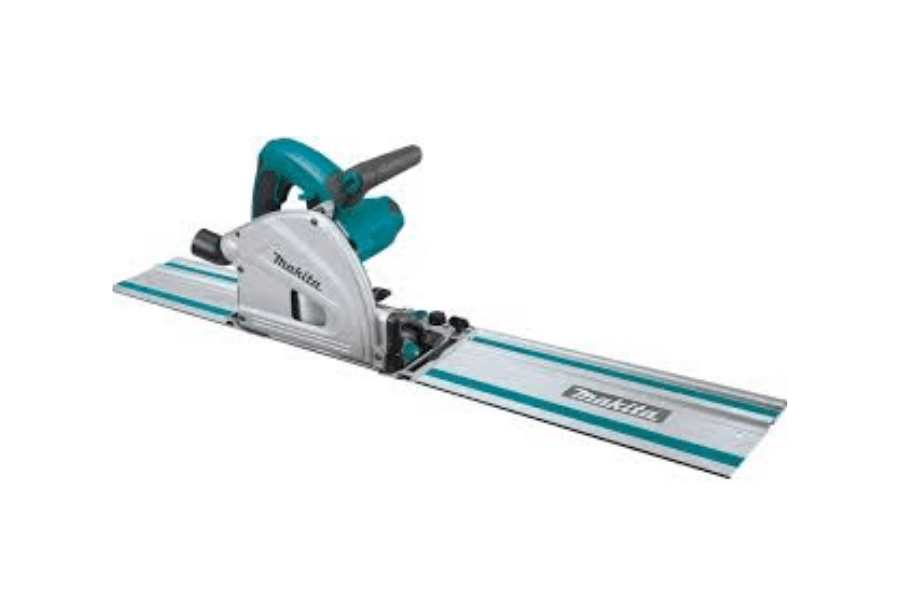
A Track Saw is a combination of a typical circular saw and guide track. The guide track is metal and has slots in it to accommodate an extra-large guard plate on the circular saw with corresponding slots. There are so many helpful options when it comes to saws for your project. Each tool has a specific purpose and function that separates it from the others. I’ve researched through the internet and put together a quick summary on the track saw.
What is a track saw used for? The track saw is used to easily cut long straight lines on sheets or panels of wood, it can reduce the size of workpieces to fit in your vehicle, efficiently cut long angles in sheetwood, make long miter cuts and can square off large panels of wood.
Keep reading below to learn more about the track saw and what it can be used for.
Table of Contents
Tracking Your Cuts With a Track Saw
As a woodworker or woodworking enthusiast, you’ve probably had to work with large sheet goods. If so, then I’m sure you’ve also come across the problem of how to make good straight cuts, in the shop or on-the-go.
This is a common problem with a simple solution. Use a Track Saw.
What Is A Track Saw?
A Track Saw is a combination of a typical circular saw and guide track. The guide track is metal and has slots in it to accommodate an extra-large guard plate on the circular saw with corresponding slots. The saw locks into the metal track and slides down its length, unable to move any direction other than forward or back.
The track typically has a rubberized or slightly adhesive bottom to give it traction on your sheet goods and keep it from shifting while cutting.
How To Use A Track Saw
Track Saws are incredibly useful and adaptable. They take on many of the jobs that your table simply cannot do. For instance, a Track Saw can cut almost any angle you need on large sheet goods or solid wood panels by repositioning the track to the angle you need.
- What happens if my sheet is too large, and my track can’t reach all the way across the sheet?
Easy, you can buy track extensions that securely lock into your original track section with rails underneath that lock into the grooves under the track.
- How do I know if the track is in the proper position?
Typically, the track will have a colored edge on the cut-side, either white, yellow, or perhaps orange. Mark the correct line on your materials and position your track’s colored edge along your mark.
- What if I need to make miter cuts?
What if you’re putting big sheet goods together at a miter or an angle? You can’t really do this on your table saw, but a Track Saw gets the job done. Like most circular saws, the Track Saw has a bevel adjustment function. Simply adjust the bevel on your Track Saw, position your track along the line you need, and operate as if you were making a flat cut.
Benefits of a Track Saw
Subscribe to WoodWorkers Guild Of America on Youtube
In this article, we’ve discussed some of the various uses for a Track Saw. We’ve established that a Track Saw is a simple, yet ingenious, modification on a basic circular saw that locks into a metal track that guides your blade to cut in straight lines.
The track’s bottom grips firmly to your cutting surface and makes the job of making large cuts on-th-go possibly, because of its ease of portability.
Is a Track Saw Worth It?
Subscribe to RR Buildings on Youtube
Woodworking Joke:
A woman walked into the plastic surgeon’s office and asked about the price of a nose job.
“Oh,” said the doc, “They usually run about $6,000.”
“Oh dear,” she said. “What can we do to make it cheaper?”
“well, we can eliminate the anesthetic. That’ll reduce it to $4,000, but it’ll hurt a lot.”
“hmmmm… anything else?”
“The post-operative pain killers are about $500.”
“Yes, we can do without them. Anything else?”
Frustrated, the doc said: “Well I suppose I could use a spoon instead of surgical instruments.”
“…okay. And that would make it?”
“How about $100?”
“Fine,” she said. “My husband had a board kickback on the table saw yesterday. I’ll have him here at 3.”

